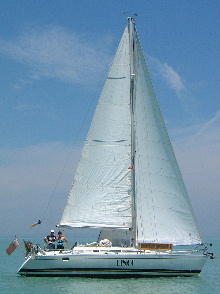
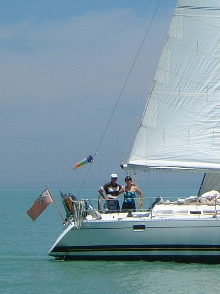

A record of the Altwasser family's sailing experiences in their yacht Bingo
Posted
by Richard at 2:13 PM
Le Treport to Cherbourg
May 27th - June 1st 2003. 182 nautical miles.
Tuesday 27.5.03 Lazy day, Le Treport to Dieppe
Leaving Le Treport just before noon, we enjoyed the warm weather and light winds and travelled just a short distance along the coast to Dieppe. The fish bought fresh in the morning markets on the quay in Le Treport was cooked in Dieppe and the cycle continued with a further purchase on the Dieppe quay-side Wednesday morning.
Wednesday 28.5.03 Fecamp

A large, turn of the (last) century, ornate brick stone and copper clock tower rising above Fecamp identified the original Benedictine distillery. Large copper stills were set in carefully tended gardens around the building, reminiscent of Royal Holloway, that now houses a museum.
A quiet evening meal on deck was accompanied by “amazing grace” performed by a lone piper from the harbour wall.
Thursday 29.5.03 Ascension day celebrations in Honfleur
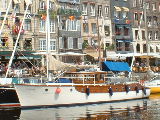
The musical entertainment in Fecamp was provided by a small band with wind instruments parading around the old harbour in traditional costume. We tied alongside Kingfisher. Distinguished from Ellen MacArthur’s round the world racing yacht, Kingfisher of Greenock is a 1930s wooden motor yacht owned by a Bristol family travelling to the Med. (Small world.)
Friday 30.5.03 Resting in Honfleur
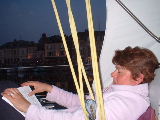
Friday was taken up with a few more chapters of Roy Jenkins’ biography of Churchill and sightseeing. The harbour-side restaurants filled soon after nine in the morning and remained packed until midnight. The novelty of being a spectacle, watched at close quarters by hundreds of tourists soon wore thin and a stroll around the town allowed us to play onlooker. 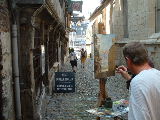
Street artists created impressions of the harbour, more challenging street scenes and the ubiquitous personal caricatures.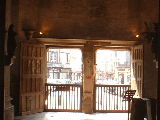

The church provided welcome shade from the hot sun and revealed an impressive pieta. 
Among the craft tied along the quay was a Dutch boat decked with flags and a party who emerged fully dressed for a wedding on Saturday morning.
Saturday 31.5.03 East to West

Early Saturday afternoon we passed from the East to the Western Hemisphere, perhaps a first for Bingo who had been in Dutch and German hands previously. Fog patches obscured our view of any of the Normandy landing beaches as we sailed the length of the Calvados coast to Grandcamp Maisy. The harbourmaster gained top points for hospitality after stopping his shower cleaning duty to write out a perfect English translation of the weather forecast and then entertaining my shower-time with an unaccompanied rendering of “Hey Jude” and “My Way”.
Sunday 1.6.05 Stormy trip to Cherbourg
The hand-written forecast had included localised storms, and at one point we were a sea mile away from thunder and lightening and not surprised to see reports in Monday’s local paper of severe local flooding including injuries. Thankfully we were neither flooded or electrified.
Monday 2.6.05 Rest and sunshine in Cherbourg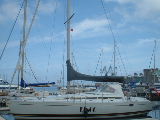
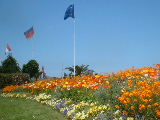
On the day before the first of a series of general strikes in the republic, we did a little more reading and shopping. 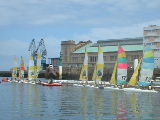
The large inner harbour and even larger outer one provide ideal shelter for novice sailors: we watched a small fleet of dinghies venture out under close supervision.
Tuesday 3.6.05 Planning and lunch out in Cherbourg
Separating Place de la Republic from the yacht harbour is a bronze statue of Napoleon on horseback, pointing menacingly in the direction of what is now the Capitainerie, as if to warn visitors to pay their dues. On the Place is restaurant La Cale, a favourite of yachtsmen, with a large wooden pillar, carved as a mast, complete with huge brass cleats and jute halyards. The pillar bore greetings from many of France's most famous racing yachtsmen, including "Merci et bientot, a douf, Ellen." France adopted Ellen Macarthur long before the Brits took note.
We hope to leave Cherbourg early afternoon tomorrow, catch the Alderney race at slack tide and arrive at Herm or St PeterPort early evening, then on to Treguier on Thursday.
Bruinisse to Le Treport
May 21st - May 26th 2003. 170 nautical miles.
Farewell Bruinisse
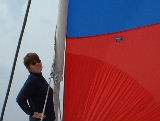
Before leaving Bruinisse we raised the Red Ensign to show publicly that Bingo was now in British hands and registered on the British ships registry. Lowering the flag, as is customary at sunset, proved more difficult, however, as we had trimmed the flagpole to such a precision interference fit in its holder that once the wood became a little wet and expanded it was impossible to remove.
Farewell Grevelingenmeer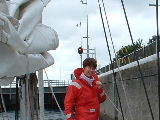
Just around the corner from Bruinisse we entered the Lock into the Oosterschelde, one of the larger areas of inland water in Holland. With a fair wind we enjoyed learning to tack and invented a new manoeuvre, the “tack-gybe.” It starts by turning into the wind, adjusting sails and then spinning through a further 360 degrees. It ends by setting the sails correctly and furtively looking round to ensure no other ship’s crew were watching. We did a few of these on the Oosterschelde before learning to tack the boat properly. Slowly we are learning.
Wedneday night in Veere
After enjoying a coffee in the quaint town of Veere, we moored just outside the town wall where ten years previously we had moored with a sailing class flotilla. On that occasion our son Ben had caught a couple of crabs, cooked them and offered the whole fleet a small delicacy of fresh crab on toast. This time we hauled a few buckets of Veere water on deck to clean down the cockpit floor and seeing the green yellow colour of the Veers water, we understood why ten years previously our friends had been so politely reluctant to feast on the crab. (Holland is famous for cheese, which starts as milk which comes from cows that live on the banks of the Veersmeer…need I say more?)
Bridges opening just for us.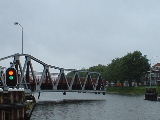
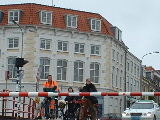
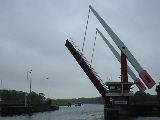
The eight mile stretch of canal from Veer to Vlissingen has several locks and bridges that open after a polite radio request to the operator. We felt very important having all these bridges open just for us. The traffic in Middelburg, more bicycles than cars, halted and we waved regally as we went on our way to the North sea. The bridges either swing or lift and are in excellent condition. We felt truly indebted to the Dutch taxpayers who make all this possible.
The North sea swell
The calm waters and gentle breeze of the Dutch canals gave no warning of the steep seas and strong breeze awaiting us in the North sea. If we had been made to feel important by the lifting bridges in the morning, we were quickly made to feel humble and vulnerable by the waves crashing over our decks for the next six hours. Bingo crashed off the top of large waves, hitting the troughs with salt water covering decks and crew. We quickly put on harnesses to reduce the risk of going overboard and put a couple of reefs in the main to reduce sail area. On reaching Nieuwpoort we were wet, tired and despite an attractive menu at the yacht club, I felt too sick to go out and eat. Liz felt fine.
The North sea had kept us so well occupied that we entered Nieuwpoort with the Dutch courtesy flag still flying. We trust the royal family will forgive us. 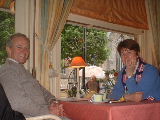
We were none too sorry to learn of further gale warnings in the North sea, an excuse for a rest day in Nieuwpoort. We caught the market, fresh fruit and veg, and enjoyed coffee in the town. Having lived in Belgium for three years, we knew the two things the Belgians do best. We enjoyed lunch at a friterie, and were visited on board by the bureaucratic might of the Belgian customs who insisted on inspecting all the ship’s documents. We had been forewarned that one question all customs officers are obliged to ask is the size of a boat’s engines, due to the use of very highly powered motor boats for smuggling drugs. For a sailing boat this question is just a formality, Bingo has a 28hp engine with maximum speed of a mere 7.5 knots. However, on being asked the engine size, Liz took a guess and said 2000hp. We regret not capturing the customs officer’s expression on camera and hope he didn’t record our answer on his form.
French sunshine and British yachts
As we sailed from Nieuwpoort to Calais and crossed into French water, we had the French courtesy flag up within moments and as if to salute us, the Republic gave us sunshine. Tacking between sandbanks and negotiating the buoyed channels in a moderate breeze and bright sunshine was fun and we timed our entrance to Calais harbour to require only a fifteen minute wait for the opening of the bridge into the inner harbour. We tied up against a larger boat and had an interesting chat with a couple from Suffolk who were taking a long, and potentially extensible summer to travel via the canals to the Med. and back. Small world!
Calais rally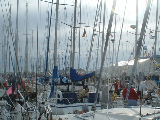
We arrived with a huge flotilla of British yachts, including a large contingent from Benfleet yacht club. We polished up our “Estuary English,” tied up along the wall, nine deep and learnt that our immediate neighbour had been stuck in Dover for a week as 40 knot gale force winds had been recorded.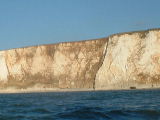
Leaving Calais on Sunday morning, the sky was again clear and we saw the cliffs of Dover clearly for several hours off Cap Gris Nez. The chalk cliffs protecting the small town of Le Treport, however, are reputed to be the tallest in Europe and make an excellent landmark for a landfall, with an obelisk on one cliff and a large cross mounted on the other, either side of the town and harbour entrance.
Our original sail plan, to enter St. Valery sur Somme was extended by 20 miles when a closer calculation of tidal heights showed a risk of running aground in the drying and shifting sands of the Somme estuary, with weak neap tidal ranges this weekend. After more than ten hours under sail, we entered the lock at Le Treport with insufficient schoolboy French to understand the intentions of the harbourmaster, who, in eventual frustration with us, abandoned his control tower, drew a small picture on the back of an envelope showing where we should moor, and knelt down at the top of the lock to pass the sketch down to us. After a seventy mile sail we tied up with other yachts and fishing boats in a well protected inner harbour at Le Treport.
God save the Queen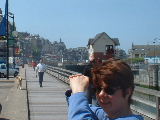
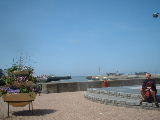
Queen Victoria first visited Le Treport one hundred and sixty years ago and with the opening of the Paris railway the fishing town became fashionable with Parisian holydaymakers. Before Tuesday breakfast we strolled around the town and bought baguettes and fresh fish from the quayside.
Later, we climbed the chalk cliffs from where the development from minor fishing town to favoured holiday resort could clearly be seen, with rows of buildings competing for the best views. Late 19th century hotels obscured the view of earlier townhouses, and 20th century holiday apartments eclipsed many of the hotels. With new residential development underway on the cliff top and the quayside lined with dozens of restaurants and a modern well-staffed tourist office, we deduced that the town is still popular. 

Looking North from the cliff top showed the prominent position of the large 18th century cross.
Le Treport quayside was decorated in brightly coloured flags, ready for the holiday season. We wondered if it was mere coincidence that the fishing boats were also brightly painted.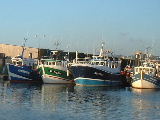
We will leave Le Treport later this morning with good memories. The Internet cafe from where I am uploading these pictures has a view over the sea, is free and the supervisor has welcomed me with coffee. The hospitality here has been great although I did detect a cheeky grin on the face of the young harbourmaster when he explained to Liz that the Ladies showers were closed for repair but Madame was welcome to join the gentlemen. Next we head for Fecamp and then Honfleur.
Have faith!
Such is my fallen nature, that faith in God is aroused less by fine weather than by Netherlands coastgaurd gale warning Nr 91 Issued 20:40 UTC 19th May: Dover; Thames; Humber; German Bight, West to Southwest 7.
A low west of Scotland is moving eastwards, roughing up the north sea as it passes. However, the low is filling and as it heads towards Norway the winds are reducing and veering in a much more helpful North West direction.
Its good to have Navtex weather forecasts broadcast digitally several times a day from stations all over Europe. If we still feel uninformed, we can also stick our noses out of the cabin and look upwards or even wander along the pontoon to the harboumaster’s noticeboard.
Mia Culpa.
In the few days we have allowed ourselves to prepare the boat we have been out on the Grevelingenmeer three times and experienced a minor mishap on each occasion. Not the outworking of Murphy’s law I’m afraid, but operator error. As former colleagues would say “RTFM error” (Read the flippin’ manual!)
Keen to try out the massive new cruising chute, I attached a couple of bits of string (technical term for lines of grossly inadequate breaking strain) and for several minutes we sailed in awe of the speed. We recorded on camera a speed of 6.3 knots in 7.7 knots of wind, but the camera click was followed by two high pitched pings and the chute fluttered freely in the breeze.
Rummaging through the lockers we found adequate lines for a second attempt to test the chute. With 5.8 knots in 6.2 knots of wind, standing on the foredecks admiring the view, the autopilot failed, the boat turned out of control and wrapped the massive chute around the forestay. It was fun to unwrap it and stow the sail whilst locking the wheel steering manually. The autopilot sprang to life again as soon as I turned it on properly.
On a third trip the backstay was not tightened properly and consequently the Genoa halyard wrapped around the top of the roller furling gear preventing it from unfurling correctly.
As a consequence we now have an “Idiots guide” to setting sail, including turning on the Autopilot, tightening the backstay and even putting the cap on the soap dispenser so it doesn’t spill as it flies around the cabin in rough seas.
Final preparations.
It rained all day yesterday, a forced opportunity to read a few more flippin’ operator’s manuals, calibrate the depth sounder and wind set, check over the engine, and buy sufficient spares to service it twice.
Weather permitting, tides allow us to sail for four days to St. Valery sur Somme, staying on route at Veere, Nieupoort and Calais. We hope to spend Sunday at St. Valery and try to understand why William the Conqueror should wish to leave such a place to invade Britain. We then sail to Fecamp and stay for a day, then on to Honfleur on the Seine estuary for another rest day.
Looking out a little, we would like to be anchored of Herm by the beginning of June where we may pick up Chris, to help navigate round the rocky bits off Brittany. This first leg aims to bring us to La Rochelle by June 18th.
That’s the plan, weather permitting we set sail tomorrow morning.
Farewell Oxford. Hello Bristol.
All seafarers need buoyancy, and we certainly felt well supported leaving Oxford.
We enjoyed several dinners with friends and a casual open house on Easter Monday when more than thirty friends and neighbours dropped by to wish us well in a steady stream from early afternoon to late evening. I let slip that I had to work a further week in Oxfordshire after moving to Bristol and received four offers of accommodation. I enjoyed scoring a final goal with village football friends, turning up afterwards muddy and sweaty at a friend’s house and yet still being welcomed with a shower and a beer (yes, in that order!).
More than fifty colleagues, including the CEO, assembled for a group photo to help me remember my two and a half years with the company. They clubbed together for a copy of Ellen Macarthur’s “Taking on the World”; a very special nautical knife with marlin spike and shackle key; some decent cigars and a card covered in greetings, including some unusual poetry. A group of twenty met for a beer and curry on my last Friday evening, May 2nd, and one dear friend, who travelled from Swindon just to join us, spent a small fortune on providing the table with bottles of Moet. It was a good and happy send-off.
I was sick on the days leading up to the move (well timed), and so a neighbour helped pack and clean, and thankfully the removers delayed the loading, allowing us a further night to finish packing. Ben arrived back from three weeks in California on the morning we moved and despite being jet-lagged and not sleeping on the overnight flight, he worked all day like a trooper. I only needed to wake him once.
Much to the amusement of the removers, we had a detailed plan showing the position of every piece of furniture to 5 cm accuracy. This was a necessary pre-requisite when down-sizing from five bedrooms to three. Thanks to Ben, Ruth and Chris who measured up, everything fitted perfectly.
Life on the park
Life at the top of the park is wonderful. As I type this, and look out of our window, I can see acres of rolling green grass, freshly mown this morning. Large mature chestnuts, oaks, beech, deep evergreen ilex and many other trees surround a lake, tennis courts and bowling green. The pink and white blossom is now almost gone. In the mornings I join the many who enjoy jogging around the park and the dogs being exercised, and yes, the owners really do scoop the poop. The park is always alive, people fish in the lake, the dog-walkers and joggers are joined by those who choose the park as their route to work, school or shopping and those just out for a stroll or power-walk. People sit on the benches to rest, take in the view, play with children or feed the ducks who wander right up to our front door, stopping the traffic as they waddle unhurriedly across our street. The spring weather changes rapidly and repeatedly from brilliant sun to heavy showers several times daily and yet the park stands unmoved, its natural majestic beauty can wear rain or shine and remain pleasing in all weathers.
We’ve met four of our neighbours and still smile at the west country accent. Neighbours have time to stop and talk and conversation always turns to how much they enjoy the park. The couple we bought from had agreed with each other that if they didn’t like their new home they would return to Bristol, but only to this street.
In our first week we catalogued the boxes stored in the roof, unpacked the rest, wired in broadband and an Ethernet Lan, put up eleven shelves, five mirrors, three clocks, thirty eight pictures, two curtain rails, five new sets of curtains, including two we made ourselves, four smoke detectors and filled eight bookshelf units with books.
Two children, four grandparents and three friends visited us and said that it was good, so we felt blessed by their appreciation and on the seventh day we rested from our work. We slept almost all day on Sunday.
We woke in time for a second visit to Christ Church Clifton. In Oxford we used to joke about hoping one day to find a Church congregation as friendly as All Saints Sutton Courtenay, with the preaching of St Andrews in Oxford and the music and choir of Christ the King Frankfurt. Christ Church Clifton may be God's answer to our little joke which, appropriately, used to run: and if we find our dream church we will be careful not to stay too long and spoil it.
Owl and Pussy Cat?
Decision time: November 23rd 2002. Did Edward Lear capture the balance of practical planning and romantic adventurism that resulted in us going to sea? We have been sailing as a couple and a family for more than a dozen years, but never before considered it more than a recreational sport, so why give up work and home, and why now?
We had been looking forward to the visit of a friend with whom we had lost contact soon after our student days and only re-connected earlier in the summer after her husbands death. We spent a weekend telling more than 20 years of stories and took a long view. She told us we should seize life's opportunities and perhaps take a sabbatical, at least a year, and go sailing. The suggestion was both crazy and obvious. Our parents were well, kids at Uni., we loved sailing and travel. Whilst we might not have come up with the idea alone, we immediately recognised its merits.
Blame a friend? Our friend enthused about the Azores, following a recent visit, but we settled on 18 months around the Med. At least to start with. My diary entry reads “Decided to sail Med + Azores for 18m > 2yrs.” The timing seemed good, sailing would start with the better weather in May, leaving more than 5 months to find a boat, rent out our house, find a family base in Bristol where both Ben and Ruth are at Uni., and finish my job. I had decided months earlier to leave work, and had already been considering an opportunity in Switzerland. Our first priority now was to find a boat.
Which boat?
Having sailed seven different sailing yachts as a family, two owned, most chartered, we quickly assembled a wish-list and searched broker web-sites. We identified 3 on the south coast that matched requirements and budget and the favourite on paper was a Feeling 1040, a 35 ft French cruiser racer with good stability, comfort, speed and manoeuvrability.
After several December weekends crawling over yachts, our first instincts were confirmed, a Feeling 1040 or its successor 1090 it had to be. However, our first choice had been sold just hours before our appointment to see it.
By late December we had identified 7 further candidates and assembled a large spreadsheet comparing more than 50 parameters and estimating the cost to kit out each to a good cruising standard. One on the East coast, 4 on the South coast, one in Greece and two on the French Riviera. So a pre-Christmas jaunt to see Uncle David’s new home near St Rapheal turned into a boat hunting expedition. Our choice was a 1090 whose seaworthiness had recently been proven in an Atlantic crossing.
Buying abroad
Never having bought a boat in France and with rusty French language skills, we were glad of the natural pause in brokerage business that Christmas provided in order to gather our thoughts and prepare to negotiate with the French broker. Local friends helped complete my translation of a French purchase contract. The legal advisor at the Royal Yachting Association gave advice generously and sent useful documents on buying in France. The CEO of the Yacht Builders Designers and Surveyors Association gave further helpful info and sent alternative draft contracts. We found a local French Surveyor who spoke perfect English and was a recognised member of the YBDSA, as required to get a tonnage measurement necessary for British Part 1 registry.
By New Year we felt prepared to do business and so emailed to the French broker an amended contract and a list of questions and conditions under which we would proceed. But again we had been beaten to it. A local Frenchman had placed a deposit between Christmas and New Year.
By this time a sense of urgency had entered our search. Our third target, also on the French Riviera, was a compromise: it had a tiller and we wanted wheel steering. We negotiated a pre-survey price that included conversion but had misgivings about the wisdom and expense and uncertainty about committing to this work at such a distance. The broker was helpful, sent a contract in English, agreed to all our requests for documents proving ownership, registration and VAT status, but struggled to get in contact with the owner. On 9th January we learnt that the owner had already sold the boat and failed to inform the broker.
Time running out
More than 6 weeks of our 5 month preparation time had gone. In order to sail in May I needed to resign my job at the beginning of February, just three weeks away. All our efforts had shown zero progress to date. From our identified list of 8 yachts, five had sold, one was inaccessible and three were too expensive. Looking on the bright side, this confirmed our choice of model as a popular one and suggested good chances of reselling after our sabbatical.
Around midnight on Friday January 10th we found a further broker web-site, this time in Holland. I’d read articles suggesting that Dutch prices could be attractive and I’d worked a lot in Holland and felt comfortable with Dutch business practices. This broker had both a 1040 and a 1090. On Saturday morning we established contact, were unsurprised that the broker spoke perfect English, exchanged copious details by email and Fax, completed most of our 50 point comparison spreadsheet and arranged to visit on Sunday.
We rose in the early hours, took the tunnel, saw the sun rise over France, passed ice skaters on a lake in Holland and were glad to be welcomed with refreshing strong hot Dutch coffee at noon in Bruinisse. 
The 1040 was perfect. More than perfect, it had features such as two aft cabins and a recently epoxy coated hull that set her apart from all the others we had looked at. The ritual price haggling was straightforward. We agreed a price by mid-week and signed a contract by fax, subject to survey, the following weekend. Gerry the broker was a gentleman whose sailing experience included a sabbatical on the Med. with his wife and working with the main Dutch importer of Feeling yachts. We learnt a lot from him.
During our visit, we took more than 50 photos of the boat and spent several hours back in Oxford scrolling through them on our laptop, seeing details we had missed and compiling several pages of questions. 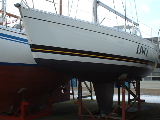
Why "Bingo"?
We discussed the boat’s name, “Bingo.” Neither of us would have chosen this name, but after three successive previous disappointments, it reflected our pleasure that our number had come up at last. Also, with plans to travel where English is not a first or even second language, Bingo is easily articulated and spelt. We hope never to have to report “Mayday Bingo” over VHF, but, as the authors of “Sell up and Sail” have noted, when sailing abroad, boat names such as “Ploughboy of Loughborough” may not be the easiest to accurately communicate in an emergency. So we decided to keep the name Bingo although we are still a little concerned that it might provoke "friendly fire" when sailing through the firing ranges off the Bordeaux coast.
We found a local Dutch surveyor who worked for a large Ipswich firm and agreed to meet on Friday January 31st. Again we travelled through the night and started the survey together mid-morning. The surveyor was familiar with the “Hot-Vac” treatment to the hull, which had been pioneered in Suffolk and exported to Holland. From the surveyor’s knowledge and the brokers photos and documents, we were able to understand the technical details of why the hull was now in better condition and less susceptible to osmosis than when new. Our several pages of questions were answered. Bingo was found to need a few minor repairs, which the broker happily agreed to. That evening we booked into a small Hotel near Brugge, too exhausted to eat out, but knowing there was now no turning back. 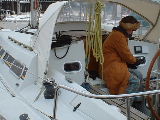
On Saturday we returned to Oxford through snow and ice, I wrote a resignation letter on Sunday and on Monday agreed with my employer that I would leave on May 2nd. But what about renting our home in Oxford and what about finding a family base in Bristol?
Explaining our decision.
We were determined to tell key family and friends immediately of our decision in November, but were wary about how it might be received. In retrospect we should have spent much more time earlier with our children explaining our reasons and working through how they would be affected. It was quite late on when we learned that we had won great street cred. among our kid’s friends, all of whom felt it was a great thing to be done by the parents of someone else. We were pleasantly delighted at our parents’ supportive reaction and chuffed by many friends who described the decision as brave. Some friends were honest enough to admit that it made a great topic of conversation, but was not a decision they would have made. I returned to weekly village football in March, after a 4 month gap, and discovered that our plans had been thoroughly discussed on the football field even though I had not personally told any of them.
The most common sentiment among work colleagues was envy. Expressions of how I would be missed came from unexpected sources, together with good wishes and invitations to lunches. More than one opined reassuringly that this would not be a career limiting step.
Not a single family member, friend or colleague sought to discourage us.
Fitting out.
In February and March my home study room grew to resemble a small chandlery. I collected anchor and chain; GPS; Navtex; a wind measuring set; a cruising chute sail; several home created fittings, dozens of charts, almanacs and cruising pilots; fenders; warps; a liferaft; inflatable tender and outboard engine. In each case I tried to use the principle of making decisions after seeing the goods at chandlers or the boat show and then shopping around for the best deal.
I travelled alone to Holland in late March, again through the night, and with the help of Dennis, the broker’s technician, in one weekend we fitted most things that required climbing the mast or making holes in the deck.
Also during this period we sorted all the paperwork: Insurance with third party translations in Spanish and Italian, Small Ships Register (SSR) registration (we decided to avoid the costs of Part one registry, but ensured we had the necessary 5 year proof of ownership if needed;) VHF registration; International Certificate of Competence and VHF operators licence. Whilst we had sailed in several countries and never once been asked for any of these, we wanted to be sure that we had all the paperwork in place that might possibly be requested anywhere between Holland and Turkey.
Test sail. 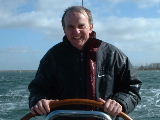
The weekend set aside for a test sail was windy. A force 7 blew in the marina. Bingo’s 35 feet length was tied in the 36 foot gap between a mooring pile and a pontoon and with other yachts on either side there was little room for lateral error either. We edged out of the mooring, 32 knots of wind behind us, and less than a boat length between rows of pontoons.
We tested Bingo under engine on Saturday. Achieving 7.2 knots directly into a force 7 confirmed the wisdom of having a substantially sized engine. The 28 hp Volvo was more than twice the size we had been used to and in busy areas and strong wind conditions it was good to have. On Sunday the wind dropped to 15 knots and we tried Bingo under sail. We had been used to 4 knots in such a breeze and were delighted to clock 7 – 8 knots, peaking at 8.2. the sail area under full main and Genoa is 67 square metres. We kept the extra 70 square meter Cruising Chute in reserve, still to be tried, perhaps useful for water skiing (Joke).
This first test sail also showed just how manoeuvrable the boat is, turning within it’s length.
Renting our house. 
Perhaps we should not have been surprised that people were attracted to our house for the proximity to the European School. We selected the two most professional agents we could find, showed half a dozen families around, none of them British, and agreed a deal with a family we feel sure will settle easily.
Finding a home in Bristol.
December and January were devoted to tracking down a boat. This left February and March to find a family base in Bristol. We bought maps; registered with Estate Agents; researched the crime figures for different wards of the city; searched, researched and searched again on every Bristol property site on the internet and spent most Saturdays viewing and asking questions. We learnt that Bristol is a very diverse city with prices for the same property varying by a factor of 3 or more across a distance of less than 3 miles. We learnt that it is one of the top ten crime cities in the UK, but that this is concentrated in a few easily identified areas, some of which the police described to us as no-go zones. There are many pleasant quiet leafy areas as well and Bristol was recently voted the most friendly city in the UK.
By mid February we found the street in which we wanted to live, overlooking a park with a lake and with easy access to the motorway. We all agreed that of all the streets we had visited, this was our unanimous choice. We put in an offer on the only house for sale, only to find ourselves in a bidding competition with another buyer. We raised our offer once and then withdrew. We told all the local agents exactly where we wanted to live and so were able to be the first to view when a second house in the street came up for sale. Unfortunately this had been modernised with disregard to any of the original features that made the street attractive and had been partitioned up for student letting. Together with the agent, we excused our embarrassment as we were shown around one student room while the two co-occupants lay in bed watching TV.
By late February we had a tenant who wanted our house from May 1st and started to wonder whether we would need to put our belongings in store. We decided, however, on a compromise and offered on a house in a different area.
A house with a view
In mid March, on our third visit to view the house we were buying, and a few days before we expected to sign contracts, we just happened to drive along the street of our first choice, overlooking the park and the lake, and noticed, to our surprise, that a third house had appeared on the market. Late that Saturday afternoon we persuaded the agent and owners to show us round and were delighted to find that not only had many features been restored rather than modernised, but that it also had extra space compared with the others in the street. We haggled on price a little and took possession a month later. By mid April we had a house in the street of our choice, with a view over the park, and two weeks in which to tidy up and move.